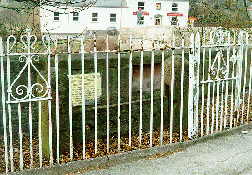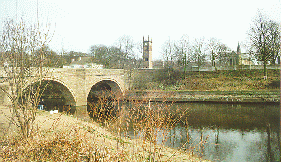![[mill and bridge]](kearmill.gif)
Kearsley (Kersley), Ringley, Prestolee and Stoneclough lie in the Irwell
valley, the river providing the basis for early settlement and
industrialization. Early industry stated with handloom weaving, but coal
brought papermaking, and the Bolton to Salford railway opened in 1838 to carry
coal, likewise the Manchester, Bolton and Bury Canal during the 1790's,
serving coal mines from the Clifton, Agecroft, Kearsley and Pendleton mines.
![[mill and bridge]](kearmill.gif)


Nathan Walworth - Walworthe - Wallwork - Wallwerk - was born in Ringley Fold 1572. His family had been settled in the area some time, in 1420, William Walwerk is mentioned as an occupier of "a pasture called Ryngleys". Nathan was born in Lancashire, but bred in Wiltshire, most likely in the house of a relative, he became steward to William the third Earl of Pembroke, and Philip who succeeded him in 1630. Nathan's letters are dated and sent from Baynard's Castle which stood on the North bank of the River Thames. These letters was sent to Peter Seddon, a resident of Prestolee who owned a family farm in the area. The name Ringley comes from Old English. Before the settlement, the area was heavily wooded, with Ringley a clearing. Hring meaning clearing and Ley meaning circular.
![[portrait of Nathan
Wallwork]](nathan.gif)
![[Wallwork family
tree]](walwrkft.gif)
![[Seddon family
tree]](seddonft.gif)
Early industry was farming and coal, mining started around 1300. A pottery at Clammermouth used clay from the bed of the Irwell,. In 1752 James Brindley build a water engine to drain the Wet Earth pit near the Clifton Kearsley boundary, the work of which was extended to cover the Botany Bay colliery too, but rather than raise water, this wheel raised coal. The nearby canal was extended with a cut called Fletcher's Canal to carry coal from these two pits. Other pits in the area are the Ringley Colliery, the Outwood Colliery.
The worst mining disaster in Kearsley was the Unity Brook Disaster on March 12th 1878 where 43 men and boys died in an explosion. Among those named are Thomas Lever, 18, Samuel Wolstenholme, 50, William Wolstenholme, 23, John Tickle Lomax, 31, James Beattie, 19, Robert (40), David (13) and Jonathan (12) Enions, Andrew Walker, 22. All are buried at St. Stephens. In 1885 176 were killed in the Clifton Hall Colliery Explosion.
The first Mill, built around 1780 was situated where the River Croal and River Irwell meet, and powered by a wheel from a weir on the Croal. Near this spinning mill was a chemical works owned by Benjamin Rawson producing acid for the bleach and paper industry.
Thomas Bonsor Crompton built a steam and water powered mill c1833 adding to the 16 mills already in the Farnworth and Kearsley area. In 1826 Clammermouth Mill was built by Joseph and Robert Lord. Kearsley Spinning Mill, owned by Edmund Turner, was destroyed by fire in 1832, probably caused by a candle (used for lighting). Rawson's chemical plant stop producing vitriol in around 1834 and the plant was sold to a Mr Wilson but closed in 1875. John Livesey had a small paperworks at Dye House Mill, but five years after it closed, paper was bring made at Crompton's Mill in Ringley, later to be called Robert Fletcher and Son. By 1897 the Bankerfield Mill and the New Prestolee Mill were among the largest spinning mills in the country. Wet Earth pit closed in 1928 after 180 years of working. Even L.S. Lowry painted a picture entitled Pit Head Scene at Wet Earth in 1925.
Of the paper industry, these are the recorded mills during the early 1800's. Creams Mill, Little Lever, founded by James Crompton 1670. Farnworth Bridge Mill, founded 1680 by Robert Crompton. Lever Hall Mill, Great Lever founded 1718 by Ellis Crompton. Grundy's Mill, Little Lever, founded by James Grundy in 1760. Livesey's Mill, Prestolee, founded 1770 by John Livesey. Seddon's Mill Prestolee, founded by Thomas Seddon 1780. Springfield Mill, Bolton, founded 1820 by James and John Livesey of Prestolee. Stoneclough Mill, founded 1823 by Ralph Crompton, becoming Robert Fletcher and Son in 1859, Robert Fletcher himself living from 1804 - 1865.
Later industry includes a coal fired power station. Kearsley Power station was built in the late 1920's, water for cooling taken from the Irwell. The power station was closed, and demolished on May 12th 1985.
Water catchment for the River Irwell comes from the following. Link Road
Stream, Middle Brook (site of Middlebrook
complex), joined by Captains Clough, joining Jenny Beck to River Croal. Eagley
Brook, joined by Astley Brook and Smithills Stream, joined at River Tonge into
the River Croal. Billy Brook, Quarlton Brook, and Bradshaw Brook turning into
Blackshaw Brook joining the River Croal.
A full index is available to all these pages.
DISCLAIMER: Errors and Omissions Excepted.
[Home] [Bolton] [Index] [Gallery] [Webcam] [Updated] [Walk] [Drive] [Links]